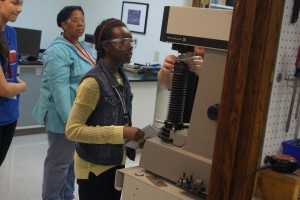Materials Engineering Summer Intern
posted May 2017Welcome to our summer intern, Atte Kadoma. Atte just completed her freshman year at Iowa State University where she is working towards a degree in Materials Engineering. We first met Atte in 2014 when she attended ASM-MN Materials Camp as a high school student. MEE is a corporate sponsor of Materials Camp and the students spend a day here getting hands-on experience in a materials testing laboratory. We even found a photo in the Materials Camp photo archives of Atte at the Rockwell hardness tester!
Atte has long been interested in pursuing an engineering degree but said her experience at Materials Camp definitely influenced her decision to choose materials science engineering as her major. She has expressed a particular interest in failure analysis.
We were very pleased to be able to offer Atte an internship this summer and look forward to working with her.
Filed under: About MEE,



